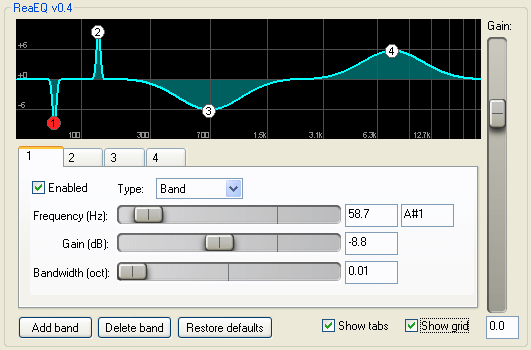IPv6Freely
Active member
I want to use the 6-band EQ for bass, but I assume the frequencies chosen are more treble-specific. What would you guys recommend changing to make this thing bass-friendly?
| GE-7 | 100 | 200 | 400 | 800 | 1k6 | 3k2 | 6k4 |
| GE-7B (Old) | 62 | 125 | 250 | 500 | 1k | 2k | 4k |
| GEB-7 (New) | 50 | 120 | 400 | 500 | 800 | 4k5 | 10k |
| RESISTER | CAP 1 | CAP 2 | Hz | Q |
| 250k | 220n | 47n | 144 | 10 |
| 250k | 100n | 22n | 313 | 10 |
| 100k | 330n | 47n | 186 | 5 |
| RESISTER | CAP 1 | CAP 2 | Hz | Q |
| 120k | 86n | 33n | 400 | 10 |
| 100k | 47n | 22n | 722 | 10 |
| 68k | 33n | 22n | 1045 | 10 |
| 68k | 220n | 22n | 400 | 4 |
| 47k | 150n | 15n | 715 | 3 |
| 68k | 68n | 10n | 1080 | 4 |
| 68k | 68n | 8n2 | 1200 | 4 |
| RESISTER | CAP 1 | CAP 2 | Hz | Q |
| 47k | 33n | 4n7 | 2700 | 4 |
| 47k | 47n | 2n2 | 3333 | 2 |

Q is the width of the frequency you're modifying.Can you explain what "Q" is?

First, let me say that I love that you reply with one BS reply and then follow it up with a real oneQ is the width of the frequency you're modifying.
Image courtesy of HomeTracked (link below).
It's oft said to cut narrow, boost wide — but really it depends on what you want to do with the EQ overall.
A wide Q affects the surrounding frequencies of the centre-freq band more than a narrow Q of same.
If you're fighting feedback, you'd want to cut the offending frequency without attenuating the fine upstanding freqy citizens surrounding it — so you use a narrow Q.
Wide EQ is probably better for a project like this 6-band, but too wide and the EQ ranges on either side of the freq you're adjusting get affected as well. A little overlap is okay, even desirable to some.
Oh, I got it. 1 octave centered on the frequency you're adjusting.Pretty much, although my understanding is that the octave for Q3 is centred around the peak of the wave — what you've described is a two-octave range surrounding the peak.
So, to use your A220Hz example, the peak would be right at 220Hz, while the troughs of the wave on either side would be midway betwen 110Hz and 220Hz, and again midway between 220Hz and 440Hz.
A quarter of an octave is on a sliding scale, so when you say "1/4 of an octave for an A is 27.5Hz", that's only true of A2 (110Hz). A quarter of A4 (440Hz) is going to be 110Hz. https://en.wikipedia.org/wiki/Piano_key_frequencies
If you cut 220Hz with a Q10, I'm not sure of the exact frequency range being cut on either side of the peak as I don't know the math involved to calculate it, but suffice it to say you've got the overall gist — a small number Q has a wide range with a soft peak, and a large Q# has a narrow sharp-peaked range; whether sharp or soft Q, the further you get away from the peak, the less affected the surrounding frequencies.
